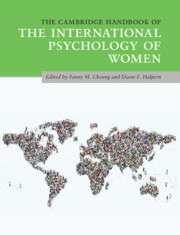59 results
Section 4 - Work and Family Issues
-
- Book:
- The Cambridge Handbook of the International Psychology of Women
- Published online:
- 20 July 2020
- Print publication:
- 06 August 2020, pp 273-372
-
- Chapter
- Export citation
Contributors
-
- Book:
- The Cambridge Handbook of the International Psychology of Women
- Published online:
- 20 July 2020
- Print publication:
- 06 August 2020, pp xiii-xvi
-
- Chapter
- Export citation
1 - International and Intersectional Perspectives on the Psychology of Women
- from Section 1 - The Underpinnings of Sex and Gender and How to Study Them
-
-
- Book:
- The Cambridge Handbook of the International Psychology of Women
- Published online:
- 20 July 2020
- Print publication:
- 06 August 2020, pp 3-13
-
- Chapter
- Export citation
Section 2 - Developmental Perspectives of the International Psychology of Women
-
- Book:
- The Cambridge Handbook of the International Psychology of Women
- Published online:
- 20 July 2020
- Print publication:
- 06 August 2020, pp 81-136
-
- Chapter
- Export citation
Acknowledgments
-
- Book:
- The Cambridge Handbook of the International Psychology of Women
- Published online:
- 20 July 2020
- Print publication:
- 06 August 2020, pp xvii-xviii
-
- Chapter
- Export citation
Section 1 - The Underpinnings of Sex and Gender and How to Study Them
-
- Book:
- The Cambridge Handbook of the International Psychology of Women
- Published online:
- 20 July 2020
- Print publication:
- 06 August 2020, pp 1-80
-
- Chapter
- Export citation
Figures
-
- Book:
- The Cambridge Handbook of the International Psychology of Women
- Published online:
- 20 July 2020
- Print publication:
- 06 August 2020, pp x-xi
-
- Chapter
- Export citation
Section 3 - Cognitive and Social Factors
-
- Book:
- The Cambridge Handbook of the International Psychology of Women
- Published online:
- 20 July 2020
- Print publication:
- 06 August 2020, pp 137-272
-
- Chapter
- Export citation
38 - Parting Thoughts
- from Epilogue - Some Final Thoughts and Take-Home Messages
-
-
- Book:
- The Cambridge Handbook of the International Psychology of Women
- Published online:
- 20 July 2020
- Print publication:
- 06 August 2020, pp 543-546
-
- Chapter
- Export citation
Tables
-
- Book:
- The Cambridge Handbook of the International Psychology of Women
- Published online:
- 20 July 2020
- Print publication:
- 06 August 2020, pp xii-xii
-
- Chapter
- Export citation
Section 5 - Inequality and Social Justice
-
- Book:
- The Cambridge Handbook of the International Psychology of Women
- Published online:
- 20 July 2020
- Print publication:
- 06 August 2020, pp 373-448
-
- Chapter
- Export citation
Epilogue - Some Final Thoughts and Take-Home Messages
-
- Book:
- The Cambridge Handbook of the International Psychology of Women
- Published online:
- 20 July 2020
- Print publication:
- 06 August 2020, pp 541-546
-
- Chapter
- Export citation
Contents
-
- Book:
- The Cambridge Handbook of the International Psychology of Women
- Published online:
- 20 July 2020
- Print publication:
- 06 August 2020, pp vii-ix
-
- Chapter
- Export citation
Dedication
-
- Book:
- The Cambridge Handbook of the International Psychology of Women
- Published online:
- 20 July 2020
- Print publication:
- 06 August 2020, pp v-vi
-
- Chapter
- Export citation
Copyright page
-
- Book:
- The Cambridge Handbook of the International Psychology of Women
- Published online:
- 20 July 2020
- Print publication:
- 06 August 2020, pp iv-iv
-
- Chapter
- Export citation
Section 6 - Health and Well-Being
-
- Book:
- The Cambridge Handbook of the International Psychology of Women
- Published online:
- 20 July 2020
- Print publication:
- 06 August 2020, pp 449-540
-
- Chapter
- Export citation
Index
-
- Book:
- The Cambridge Handbook of the International Psychology of Women
- Published online:
- 20 July 2020
- Print publication:
- 06 August 2020, pp 547-564
-
- Chapter
- Export citation
10 - Sex, Gender, and Intelligence
- from Section 3 - Cognitive and Social Factors
-
-
- Book:
- The Cambridge Handbook of the International Psychology of Women
- Published online:
- 20 July 2020
- Print publication:
- 06 August 2020, pp 139-152
-
- Chapter
- Export citation

The Cambridge Handbook of the International Psychology of Women
-
- Published online:
- 20 July 2020
- Print publication:
- 06 August 2020
Appendix A
- from Chapter 8 - Research Suffers When We All Agree
-
- Book:
- Critical Thinking in Psychology
- Published online:
- 19 December 2019
- Print publication:
- 16 January 2020, pp 193-196
-
- Chapter
- Export citation



